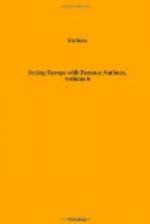Previous to reaching this place I had noticed a haggard expression upon the countenance of our guide, which was now intensified by the prospect of the ascent before him. Hitherto he had always been in front, which was certainly the most fatiguing position. I felt that I must now take the lead, so I spoke cheerily to the man and placed him behind me. Marking a number of points upon the slope as resting places, I went swiftly from one to the other. The surface of the snow had been partially melted by the sun and then refrozen, thus forming a superficial crust, which bore the weight up to a certain point, and then suddenly gave way, permitting the leg to sink to above the knee. The shock consequent on this, and the subsequent effort necessary to extricate the leg, were extremely fatiguing. My motion was complained of as too quick, and my tracks as imperfect; I moderated the former, and to render my footholes broad and sure, I stamped upon the frozen crust, and twisted my legs in the soft mass underneath,—a terribly exhausting process. I thus led the way to the base of the Rochers Bouges, up to which the fault already referred to had prolonged itself as a crevasse, which was roofed at one place by a most dangerous-looking snow-bridge.
Simond came to the front; I drew his attention to the state of the snow, and proposed climbing the Rochers Rouges; but, with a promptness unusual with him, he replied that this was impossible; the bridge was our only means of passing, and we must try it. We grasped our ropes, and dug our feet firmly into the snow to check the man’s descent if the “pont” gave way, but to our astonishment it bore him, and bore us safely after him. The slope which we had now to ascend had the snow swept from its surface, and was therefore firm ice. It was most dangerously steep, and, its termination being the fretted coping of the precipice to which I have referred, if we slid downward we should shoot over this and be dashed to pieces upon the ice below.[57] Simond, who had come to the front to cross the crevasse, was now engaged in cutting steps, which he made deep and large, so that they might serve us on our return. But the listless strokes of his ax proclaimed his exhaustion; so I took the implement out of his hands, and changed places with him. Step after step was hewn, but the top of the Corridor appeared ever to recede from us.
Hirst was behind, unoccupied, and could thus turn his thoughts to the peril of our position; he “felt” the angle on which we hung, and saw the edge of the precipice, to which less than a quarter of a minute’s slide would carry us, and for the first time during the journey he grew giddy. A cigar which he lighted for the purpose tranquilized him.




